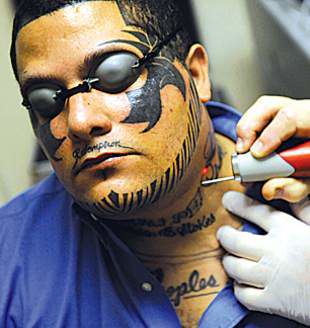Tattoo removal industry grows
Published 4:00 am Tuesday, December 13, 2011

- Wayne Stokes is undergoing up to 25 painful laser sessions to remove tattoos covering his face, neck, hands and chest.
WASHINGTON — She arrives quietly, coming in from the rain after work. She lies down on her stomach atop a sleek, white reclining chair. She lifts her shirt and tugs down her jeans slightly.
It’s enough to unveil a large pink flower tattoo with fat, webby green leaves, which she’s here to have lasered off her lower back. She wants to become a mother someday, and she doesn’t want her children to see this. The process could take up to 10 sessions, she says. She pauses. Then she starts crying.
“I was only 18. It was a homemade tattoo done at a party,” says Lizeth Pleitez, 30, who quickly dries her eyes. Her voice is shaking. “I wasn’t thinking about what it meant, you know? Little did I know it meant something — like people calling it a ‘tramp stamp.’ I’m a Pentecostal, and the body is a temple. And I felt really ashamed.”
According to the Pew Research Center, more than 40 percent of Americans between the ages of 26 and 40 have at least one tattoo. Getting a tattoo, once the province of sailors rather than suburbanites, is so mainstream that tats are inked at the mall and seen on everyone from Middle American mothers to Hollywood starlets.
Perhaps not surprisingly, a parallel trend is emerging: tattoo removal, with dozens of businesses and training schools opening across the country. Some are headed by entrepreneurs such as Ryan Lambert, who has a Harvard degree and launched a tattoo-removal training school at New Looks Laser College in Houston. He also manufactures tattoo-removal lasers.
In Washington, Ken Saler, a 61-year-old, semi-retired real estate maverick has reinvented himself. His Advanced Laser Tattoo Removal office sits above a Baskin-Robbins ice cream store and has a steady stream of customers, all trying to dial back their everlasting tributes.
“We have a client who has ‘Steve’ tattooed on her chest. But now she’s marrying Dennis,” says Saler, whose bright white office features framed Grateful Dead posters and a print of Norman Rockwell’s “The Tattooist,” in which a heavily tatted-up sailor is having his sixth romantic conquest’s name scratched off his arm, and a seventh inked on, with an evil-looking needle.
“It was such an underserved market,” says Christian Slavin, 54, who has an MBA from Harvard and owns Zapatat in suburban Washington, which opened in September. “The difference between the regret rate and the removal rate is huge.”
While older lasers burned off the skin, Slavin’s new model interacts only with the ink and “makes it shake and makes it break,” he says. But it still hurts — it feels like hot rubber bands snapping against your skin, most removers say — and often is more painful than getting a tattoo.
During a recent week, Saler’s appointment book included distraught mothers dragging their daughters in; ex-gang members with street tats who don’t want to be killed; professional women who are applying for office jobs; and African immigrants who want to get their tribal markings removed.
With a Washington location, his office draws aspiring CIA and FBI agents, along with other law enforcement operatives. If they go undercover, they can’t risk being identified by their tattoos.
As it happens, Saler is the product of a fresh start. When the real estate market crashed, he was looking for a growth industry and heard about tattoo removal. He took a two-week course to become a certified laser specialist at Rocky Mountain Laser College in Colorado, and he invested in a Quanta Q-Plus laser, which has a $90,000 price tag. The laser is on wheels and looks a little like a photocopy machine with a probe attached. His Facebook page advertises “Tramp Stamp Tuesdays” and $50 ring-finger tattoo removals after a breakup.
On a rainy Tuesday, Wayne Stokes, 34, arrives. He’s on his sixth session of a removal that might take up to 25.
He has tattoos on his face, neck, hands and chest. Both eyes are encircled by a black leopardlike Maori-inspired design, which is based on the tattoo sported by boxer Mike Tyson. The tops of his hands spell out S-U-F-F-E-R-I-N-G when he holds them side by side. The left side of his neck says “Life,” the back of his neck says “Is,” and the right side says “Pain.”
He started getting tattoos when he was 16. He says he grew up in rough neighborhoods in Baltimore, suffered abuse at the hands of his father and was threatened outside his home, too: by drugs, by peers on the streets.
“Subconsciously I was creating an image to keep people at bay and away from me. I wanted to look tough,” he says. He’s gone through a lot of therapy. He works as a cook, but when the tattoos are off, he wants to mentor abused kids.
Now that the painful decision to get rid of the tattoos is over, the physical pain begins. He prays in the bathroom for strength. He gets into the chair and squeezes a ball as the laser hits his skin, turning parts of it red and then frosted white as the ink crystallizes into smaller particles that will be removed by his body’s immune system over the next few weeks. The laser emits a green light, and the room smells a little bit like burned hair.
Saler uses a hose — known as the “Zimmer Cryo cooler” — to blow air onto the skin and deaden the sensation. “Each time, I get (part of) it removed, it’s like I can exhale,” Stokes says. “Sometimes I do dread coming in. But it’s the end result.
“I want to look in the mirror and see myself again.”






